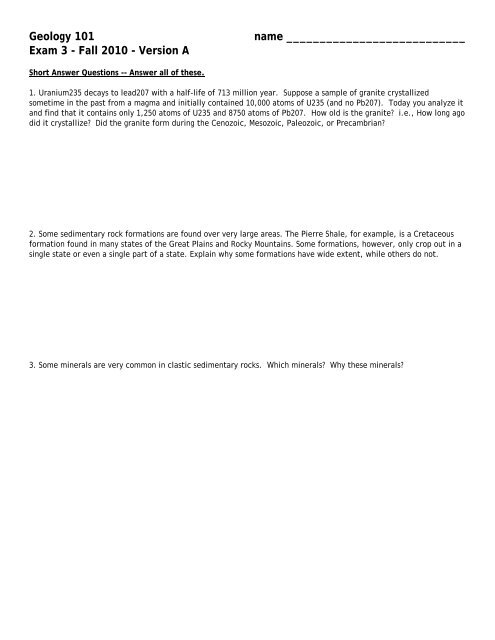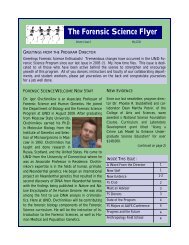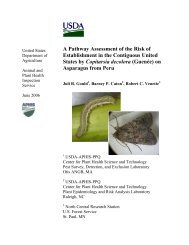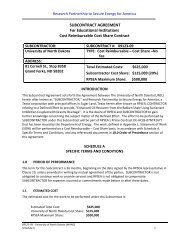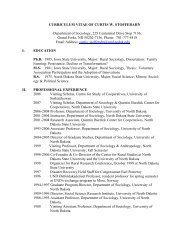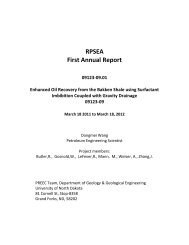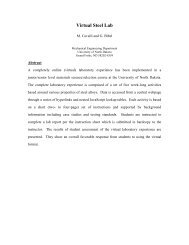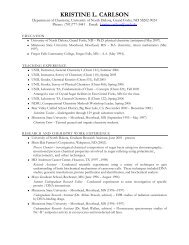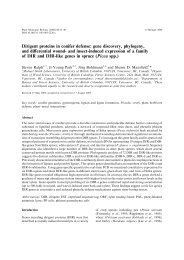Exam 3 - Fall 2010
Exam 3 - Fall 2010
Exam 3 - Fall 2010
Create successful ePaper yourself
Turn your PDF publications into a flip-book with our unique Google optimized e-Paper software.
Geology 101<br />
<strong>Exam</strong> 3 - <strong>Fall</strong> <strong>2010</strong> - Version A<br />
name ___________________________<br />
Short Answer Questions -- Answer all of these.<br />
1. Uranium235 decays to lead207 with a half-life of 713 million year. Suppose a sample of granite crystallized<br />
sometime in the past from a magma and initially contained 10,000 atoms of U235 (and no Pb207). Today you analyze it<br />
and find that it contains only 1,250 atoms of U235 and 8750 atoms of Pb207. How old is the granite? i.e., How long ago<br />
did it crystallize? Did the granite form during the Cenozoic, Mesozoic, Paleozoic, or Precambrian?<br />
2. Some sedimentary rock formations are found over very large areas. The Pierre Shale, for example, is a Cretaceous<br />
formation found in many states of the Great Plains and Rocky Mountains. Some formations, however, only crop out in a<br />
single state or even a single part of a state. Explain why some formations have wide extent, while others do not.<br />
3. Some minerals are very common in clastic sedimentary rocks. Which minerals? Why these minerals?
4. Look at the block diagram below.<br />
a. Use an arrow to clearly indicate the oldest rock formation.<br />
b. Use an arrow to clearly indicate the youngest rock formation.<br />
c. Which of the following is oldest: Fault A, Fault B, Dike A, or Dike B?<br />
d. Which of the following is youngest: the Granite, the Sill, Fault A, Fault B, Dike A, or Dike B?<br />
e. Place these three in the correct age order: the desert sand, the Sill, Fault A.<br />
5. A bright young geologist studied five of the formation in the block diagram and determined the environments where<br />
they were deposited. They are labeled in black boxes. Explain the sequence of different sediment types. Why are<br />
they what they are, and why are they in the order they are.
Multiple Choice Questions<br />
1 What version of this test are you taking?<br />
a)
other side, you find yourself going down the same limestone formation, but the slope is steeper. What kind of<br />
structure are you walking over?<br />
a) horizontal syncline<br />
b) plunging anticline<br />
c) plunging syncline<br />
d) asymmetric anticline<br />
e) asymmetric syncline<br />
9 You are bopping along a stream valley and it takes a sharp jog to the left before continuing in the original<br />
direction. You notice that other streams in the region also have similar jogs. What is most likely the cause of<br />
these features?<br />
a) a fold in metamorphic rocks<br />
b) a scarp along a strike-slip fault<br />
c) erosion of gently tilted layers<br />
d) a hogback<br />
e) regional schistosity<br />
1<br />
0<br />
1<br />
1<br />
1<br />
2<br />
1<br />
3<br />
1<br />
4<br />
1<br />
5<br />
When did fishes and creatures with shells appear on Earth?<br />
a) Mesozoic<br />
b) Cenozoic<br />
c) Precambrian<br />
d) Paleozoic<br />
e) NONE of the answers are correct<br />
How does an angular unconformity form?<br />
a) rocks are folded into an angle and the top is removed by faulting<br />
b) older rocks are tilted, eroded, and overlain by younger rocks<br />
c) rock layers are turned upside down at an angle<br />
d) angular rocks are deposited on top of flat-lying layers<br />
e) any of these<br />
Large, angular clasts are most likely at:<br />
a) On mountain slopes<br />
b) Near where a glacier ends<br />
c) In braided rivers<br />
d) In deltas<br />
e) On mountain slopes OR near where a glacier ends but not in deltas or braided rivers<br />
In some desert areas the ground is covered by a jumble of pebbles and larger rocks of varying sizes (often<br />
angular), with very little fine sand or other sediment mixed in. What do we call this?<br />
a) contact metamorphism<br />
b) unconformity<br />
c) desert varnish<br />
d) desert pavement<br />
e) none of these<br />
If you look at a metamorphic rock and see light and darkbands (containing different minerals) that are all<br />
parallel, what might be the cause of those band?<br />
a) cleavage in slate<br />
b) hornfels in a granoblastic rock<br />
c) foliation in banded gneiss<br />
d) thrust fault<br />
e) schistosity<br />
If you look at satellite photos (or geologic maps) of Pennsylvania,in many places you will see high ridges that<br />
curve back and forth forming "S" patterns. In some places they fold back and forth many times, looking<br />
somewhat like a squiggly snake. The ridges are made of quartzite which is erosion resistant; the surrounding<br />
rocks are softer (mostly shale) and so erode to produce valleys. What kinds of structures are present in this part<br />
of Pennsylvania?
a) horizontal anticlines and syncline<br />
b) symmetrical vertical anticlines and syncline<br />
c) plunging anticline AND plunging syncline<br />
d) plunging syncline ONLY<br />
e) plunging anticline ONLY<br />
1<br />
6<br />
1<br />
7<br />
1<br />
8<br />
1<br />
9<br />
2<br />
0<br />
2<br />
1<br />
2<br />
2<br />
2<br />
3<br />
What features can be used to interpret which way a prehistoric fault moved?<br />
a) scratch marks on the fault<br />
b) folding of rocks next to the fault<br />
c) the formation of folds along bends in a fault<br />
d) ALL answers are correct<br />
e) Scratch marks on the fault surface OR folding or rocks next to the fault, but NOT the formation of folds along<br />
bends in a fault<br />
If metamorphism occurs beneath a subduction zone, it typically occurs at?<br />
a) Relatively low pressure and high temperature<br />
b) Relatively low temperature and high pressure<br />
c) VERY low pressure and temperature<br />
d) ANY pressure but high temperatures<br />
e) ANY temperature but high pressures<br />
What is the best explanation if you find clasts that have no angular corners or edges?<br />
a) they are composed of relatively soft, soluble materials<br />
b) they accumulated on a steep slope<br />
c) they have been moved by the wind and rounded by blowing sand in sand dunes<br />
d) they have been transported a significant distance<br />
e) ALL answers are correct<br />
What marks the boundary between the Mesozoic and the Cenozoic (called the K-T boundary)?<br />
a) the extinction of the dinosaurs<br />
b) the start of a rise to dominance of mammals<br />
c) a meteorite impact in Mexico<br />
d) all of these<br />
e) none of these<br />
What do we call a bunch of similar rock strata that have similar composition, facies or other similar properties,<br />
making it convenient and easy to talk about them or to map them?<br />
a) Group<br />
b) Formation<br />
c) Bed<br />
d) Lithology<br />
e) Outcrop<br />
What was the Cambrian explosion?<br />
a) a large volcano that went off in Wales, which the Romans called Cambria<br />
b) a meteorite impact that struck the north coast of the Yucatan Peninsula of Mexico<br />
c) a time when a meteorite collided with the center of a supercontinent, melting all the glaciers<br />
d) a time when many different types of creatures appeared on Earth<br />
Which of these can tell us the direction that water was flowing when sediments were deposited?<br />
a) Shape of clasts<br />
b) Roundness of clasts<br />
c) Sorting<br />
d) Cross beds<br />
e) there is no way to tell<br />
In the Grand Canyon, the dominant cliff-former is the Redwall Limestone; it is up to about 500 meters thick. It is<br />
a thick Mississippian age formation. In northeastern Utah, just a few hundred miles from the Grand Canyon, the<br />
only Mississippian-age rock is the 300-600 meter thick Leadville Dolomite. Which of the following is true?
a) The Redwall Limestone and the Leadville Dolomite contain some of the same fossils. b) The two formations<br />
represent different facies of the same age. c) The different names may both refer to the same formation. d) The<br />
two formations may represent completely different depositional events. e) ALL of the answers could be correct.<br />
2<br />
4<br />
2<br />
5<br />
2<br />
6<br />
2<br />
7<br />
2<br />
8<br />
2<br />
9<br />
You find a conglomerate that overlies a granitic pluton. The conglomerate contains cobbles made of granite<br />
from the pluton. Which is true?<br />
a) the conglomerate is younger than the granite because it is on top<br />
b) the conglomerate is younger than the granite because it contains pieces of the underlying unit<br />
c) the granite is older because it is a crystalline rock<br />
d) the granite is younger because it is an intrusive rock<br />
e) the conglomerate is older because it was intruded by the granite<br />
A flat-lying conglomerate is covered by a thin formation of shale. The shale in turn is covered by a thick<br />
sandstone formation. All three units are cut by a dike made of basalt. Which is the oldest rock?<br />
a) conglomerate<br />
b) shale<br />
c) sandstone<br />
d) dike<br />
e) there is no way to tell<br />
If a rock contains a poorly sorted mix of angular and rounded clasts, what does it tell you about how the<br />
material was deposited?<br />
a) It was deposited by the wind<br />
b) It was transported a short distance<br />
c) It was transported a long distance or worked by waves<br />
d) It was deposited in a lake<br />
e) It was completely lithified before deposition<br />
How does a cross bed form?<br />
a) an abrupt change in the composition of the sediment<br />
b) a gradual decrease in the strength of the current over time<br />
c) piling of sediment down the front of a dune or ripple<br />
d) a gradual change in the climate<br />
e) two glaciers that cross<br />
If you were designing a rock that resisted weathering, which of the following characteristics would it have?<br />
a) closely spaced fractures<br />
b) a soluble chemical composition<br />
c) a quartz-rich rock<br />
d) a rock composed of abundant loose pieces<br />
e) it would be a mafic volcanic rock<br />
What is the difference between a joint and a fault?<br />
a) a joint is formed by confining pressure<br />
b) a joint is formed by differential stress but a fault is not<br />
c) a fault is formed by tension but a joint is formed by compression<br />
d) a fault displaces the rocks on one side relative to another<br />
e) joint are generally much large and involve more brittle materials<br />
3<br />
0<br />
You analyze a dike and find that it is 55 million years old. The dike cuts across a sandstone formation. It is also<br />
covered by a quartzite. Which is likely true?<br />
a) The dike is older than the sandstone and the quartzite<br />
b) The dike is younger than the sandstone and the quartzite<br />
c) The dike is younger than the sandstone but older than the quartzite. d) The dike is older than the sandstone<br />
but younger than the quartzite<br />
e) ALL answers are correct<br />
3 In what environments does low pressure/high temperature metamorphism occur?
1 a) near magma but at shallow levels<br />
b) near magma but at deep levels<br />
c) under normal conditions of burial and heating<br />
d) in a subduction zone or accretionary prism<br />
e) NONE of these answers is correct<br />
3<br />
2<br />
3<br />
3<br />
3<br />
4<br />
3<br />
5<br />
3<br />
6<br />
In what environments does high pressure/low temperature metamorphism occur?<br />
a) near magma but at shallow levels<br />
b) near magma but at deep levels<br />
c) under normal conditions of burial and heating<br />
d) in a subduction zone or accretionary prism<br />
e) NONE of these answers is correct<br />
What sedimentary environments dominate the area around Vancouver, British Columbia?<br />
a) deposition of sediment carried by a braided river<br />
b) large landslides that blocked a narrow ocean channel<br />
c) large ocean waves that carry large boulders far inland<br />
d) a scenic offshore reef that protects the coastline from large waves<br />
e) talus slopes and fringing reefs<br />
If you drive down the Yellowstone River valley between gardiner and Livingston, Montana, you will see many<br />
river terraces at different levels. In some places, three or four different levels of terraces can be seen. What<br />
can you conclude about the uppermost terrace?<br />
a) It is older than the modern river channel<br />
b) It formed sometime in the past<br />
c) It predates erosion down to the present level<br />
d) It is older than the terrace beneath it<br />
e) all of these<br />
You find a fault that involves only horizontal movement. What kind is it?<br />
a) normal fault<br />
b) reverse fault<br />
c) strike-slip fault<br />
d) oblique-slip faults<br />
e) thrust fault<br />
What type of fault is especially common on mid-ocean ridges?<br />
a) dip-slip fault<br />
b) normal fault<br />
c) strike-slip fault<br />
d) reverse fault<br />
e) dip-slip OR normal fault only<br />
3<br />
7<br />
3<br />
8<br />
When did mammals first become plentiful and very diverse on Earth?<br />
a) Mesozoic<br />
b) Cenozoic<br />
c) Precambrian<br />
d) Paleozoic<br />
e) Neogene<br />
You study a fold in northern Iraq. In a map view (or a satellite view) it looks like one simple fold. The rock layers<br />
run to the northeast, curve around, and then continue to the southwest. If you look at a cross section of the<br />
fold, you fin it is U-shaped. What kind of structure is this?<br />
a) horizontal anticline<br />
b) horizontal syncline<br />
c) plunging anticline<br />
d) plunging syncline<br />
e) asymmetric anticline
3<br />
9<br />
4<br />
0<br />
4<br />
1<br />
4<br />
2<br />
4<br />
3<br />
4<br />
4<br />
4<br />
5<br />
4<br />
6<br />
4<br />
7<br />
Which of the following matches a sedimentary rock with a possible metamorphic equivalent?<br />
a) sandstone greenstone<br />
b) basalt marble<br />
c) limestone quartzite<br />
d) shale slate<br />
e) NONE of these answers is correct<br />
Which of the following sites would have sand and silt deposited by slowing of the current?<br />
a) On mountain slopes<br />
b) Near where a glacier ends<br />
c) In braided rivers<br />
d) In deltas<br />
e) Near a stream's headwaters<br />
Which of the following is NOT accurately dated at between 4 and 4. 6 billion years old?<br />
a) the oldest dates on mineral grains on Earth<br />
b) age of the oldest meteorites<br />
c) age of moon rocks returned to Earth and dated<br />
d) isotopic ages on Earth's oldest known fossil shell<br />
Which of the following is most likely to occur at deep crustal levels?<br />
a) ductile behavior<br />
b) brittle deformation<br />
c) fracturing<br />
d) only minor changes in minerals<br />
e) NONE of these answers is correct<br />
Which of the following does NOT help create a foliation in metamorphic rocks?<br />
a) a dominant orientation of crystals, such as mica<br />
b) light- and dark-colored bands<br />
c) flattened shapes of deformed objects, such as pebbles<br />
d) crystals that grow in a random orientation<br />
e) ALL answers are correct<br />
Which of the following features look like fossils but are not?<br />
a) footprints from dinosaurs and other creatures<br />
b) burrows excavated by worms and other creatures and filled by other sediment<br />
c) leaves and other plants formed on land<br />
d) dark minerals that grow in branching patterns<br />
e) all of these are fossils<br />
Which of the following is a valid statement about how rocks respond to stress?<br />
a) If the stress is very high, the rock will be unchanged.<br />
b) Stress can cause a rock to be displaced, but not rotated.<br />
c) If a rock has strained, then it has changed its size or shape.<br />
d) A rock can be displaced or strained but not both at the same time.<br />
e) They dissolve and lose volume<br />
Which of the following situations would result in angular clasts?<br />
a) transport of the clasts over long distance<br />
b) working of clasts by waves on a beach<br />
c) steep slopes in a mountain<br />
d) dunes formed by wind<br />
e) ALL answers are correct<br />
Which of the following chapters in geologic time occurred before there were abundant animals with hard parts?<br />
a) Cenozoic<br />
b) Mesozoic<br />
c) Paleozoic
d) Precambrian<br />
e) Mammalian<br />
4<br />
8<br />
4<br />
9<br />
5<br />
0<br />
5<br />
1<br />
5<br />
2<br />
5<br />
3<br />
5<br />
4<br />
5<br />
5<br />
Which of the following sites would most likely have turbidity currents?<br />
a) beach<br />
b) lagoon<br />
c) coral reef<br />
d) deep seafloor<br />
e) tidal flat<br />
Which of the following is NOT a type of carbonate rock?<br />
a) limestone<br />
b) travertine<br />
c) dolostone<br />
d) shale<br />
e) a rock formed from a coral reef<br />
Which of the following is NOT a common type of cement in sedimentary rocks?<br />
a) calcite<br />
b) pyroxene<br />
c) silica<br />
d) iron-oxide minerals<br />
e) carbonate material<br />
Which of the following environments would most likely form limestone?<br />
a) beach<br />
b) lagoon<br />
c) coral reef<br />
d) deep seafloor<br />
e) tidal flat<br />
Which of the following is most likely to occur at shallow crustal levels?<br />
a) ductile behavior<br />
b) brittle deformation<br />
c) growth of new minerals<br />
d) recrystallization of minerals<br />
e) metamorphism<br />
Which of the following is a good interpretation of the environmental significance of an attribute of a<br />
sedimentary rock?<br />
a) Red rocks typically form in deep oceans.<br />
b) Thick bedding implies rapidly changing conditions.<br />
c) Fossils indicate that a sediment was deposited in water.<br />
d) Graded beds indicate that the strength of the current decreased through time.<br />
e) NONE of these answers are correct<br />
Which of the following environments would most likely consist of sand and/or rounded cobbles?<br />
a) beach<br />
b) lagoon<br />
c) coral reef<br />
d) deep seafloor<br />
e) tidal flat<br />
Which of the following is most likely to deposit a conglomerate?<br />
a) landslide<br />
b) braided river<br />
c) steep mountain front<br />
d) sand dunes<br />
e) lagoon
5<br />
6<br />
5<br />
7<br />
5<br />
8<br />
5<br />
9<br />
6<br />
0<br />
Which of the following attributes does NOT apply to these sediments that are found deposited by landslides?<br />
a) angular clasts<br />
b) cobbles and boulders<br />
c) well sorted<br />
d) contains gravel<br />
e) contains sand and dirt<br />
Which of the following is a characteristic of fine-grained clastic rocks?<br />
a) most clasts are visible with the unaided eye<br />
b) the rocks are poorly sorted<br />
c) the cobbles directly rest on one another without much matrix<br />
d) the rocks tend to be easily eroded<br />
e) they have an iron oxide cement<br />
Which of the following can cause rocks to fold into large anticlines or synclines?<br />
a) Compressive forces<br />
b) Extension forces<br />
c) Gravity<br />
d) Differential stress<br />
e) ALL answers are correct<br />
Which of the following is a common characteristic of carbonate rocks?<br />
a) they commonly have a dissolved appearance<br />
b) they are commonly black and shiny<br />
c) they are commonly reddish<br />
d) they do not form cliffs<br />
e) ALL answers are correct<br />
Which of the following environments would likely have clasts smaller than sand?<br />
a) a weak current<br />
b) steep slopes<br />
c) dunes formed by wind<br />
d) All answers are correct<br />
e) a weak current OR steep slopes but NOT dunes formed by wind


